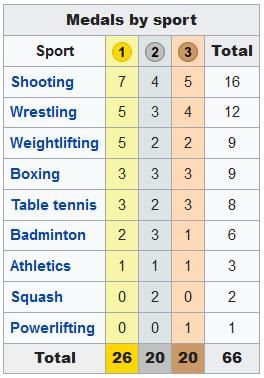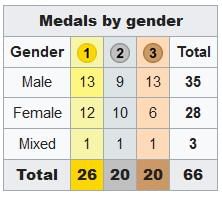Current Affairs Mock Test 1 - UPSC MCQ
25 Questions MCQ Test Additional Study Material for UPSC - Current Affairs Mock Test 1
Consider the following statements regarding Ken-Betwa river interlinking project.
1. It is the country’s first river interlinking project.
2. Ken and Betwa rivers originate in Madhya Pradesh and are the tributaries of Yamuna.
3. Ken River passes through Panna tiger reserve.
Which of the above statements is/are correct?
1. It is the country’s first river interlinking project.
2. Ken and Betwa rivers originate in Madhya Pradesh and are the tributaries of Yamuna.
3. Ken River passes through Panna tiger reserve.
Which of the above statements is/are correct?
If crude oil price goes up in the international market, what impact will it have on India?
1. Increase in trade deficit
2. Decrease in GDP (gross domestic product)
3. Rise in inflation
2. Decrease in GDP (gross domestic product)
3. Rise in inflation
| 1 Crore+ students have signed up on EduRev. Have you? Download the App |
With reference to the Commonwealth Nations, consider the following statements:
1. It was founded in 1931.
2. All its members must be former colonies of the British Empire.
3. India became its member in 1950.
Q. Which of the statements given above is/are correct?
2. All its members must be former colonies of the British Empire.
3. India became its member in 1950.
Who among of the following can only be removed from their post by impeachment or impeachment like process?
1. The President of India
2. The Prime Minister of India
3. Chief Justice of India
4. Attorney General of India
With reference to the monetary policy of the Reserve bank of India, which of the statement given below is INCORRECT?
Which of the following is/are related to the meaning of the word ‘Guillotine’?
1. A method of Death penalty
2. Acceptance of ‘Demands for Grants’ in Parliament
3. A type of protein found in the human body
For which of the following places does China continue to dispute with India?
1. Asaphila
2. Doklam
3. Pangong Lake
With reference to the ‘International Energy Forum’, consider the following statements:
1. This organization consists of nations involved in 90 percent of world’s energy demand and supply.
2. The headquarter of this organization is in Riyadh, Saudi Arabia.
3. Its 16th Ministerial conference was held in India in 2018.
Q. Which of the statements given above is/are correct?
Which of the following sector does the World Trade Organization (WTO) regulate?
1. Goods
2. Services
3. Intellectual property
4. Environment protection
Which of the following industries come under the ‘core sector’ of the economy?
1. Steel Industry
2. Chemical fertilizer
3. Textile Industry
4. Petroleum Industry
5. Cement
In which country did the incident related to ‘Labor Day’ occur on May 1, 1886?
With reference to the ‘Dehang-Debang Biosphere Reserve’ constituted in 1998, consider the following two statements:
1. It is located in Arunachal Pradesh.
2. It has natural vegetation stretching in an unbroken sequence from the tropics to mountain tundra.
Q. Which of the statements given above is/are correct?
From where does Bajau tribe, also known as ‘Marine tribe’, belongs to?
Who presents the Union budget of India in the parliament?
Which of the following groups of places is not included in ‘Buddhist Circuit’?
Identify those which are part Nordic countries:
1. Norway
2. Sweden
3. Denmark
4. Switzerland
5. Finland
With reference to the ‘Commonwealth Games 2018’ held in Australia, consider the following statements:
1. India displayed its best performance ever in the history of Commonwealth Games.
2. Women athletes won the highest Gold medals for India.
3. India won the highest Gold medals in Shooting.
Q. Which of the statements given above is/are correct?
Which of the following is not included in the objectives of ‘Rashtriya Gram Swaraj Abhiyan’?
The Armed Forces (Special Powers) Act, 1958 has been implemented in which of the following states/territories till date?
1. Arunachal Pradesh
2. Assam
3. Naxalite area of Chhattisgarh
4. Mizoram
5. Meghalaya
With reference to the process of removal of the Judges of the Supreme Court by impeachment, consider the following three statements:
1. Judges can be removed only on the basis of their proven misbehavior and incapacity.
2. The impeachment process for judges is mentioned in the Constitution.
3. The impeachment motion requires to be passed by a special majority in both the houses.
Q. Which of the statements given above is/are correct?
With reference to Cambridge Analytica firm, consider on the following statements:
1. This is an American firm.
2. Its main business is to provide political consultation.
3. Due to allegations of personal data theft, the firm finally closed its operations.
Q. Which of the statements given above are correct?
Which of the following has a mention of the obligations regarding protection of monuments, places and objects of artistic and historical interest that have been declared by or under law made by the Parliament to be of national importance?
With reference to the Cantonment Council, observe the following:
1. The Cantonment Act, 2006 has been enacted by the Central Government.
2. The Executive Officer of the Council is appointed by Government of India.
3. It works under the administrative control of the Ministry of Defense.
Q. Which of the ideas given above are correct?
In what ratio (percentage-wise) will the expenditure of ‘Ayushman Bharat’ scheme be borne by the Central and State Governments respectively?
With reference to the ‘Nuclear Supplier Group’, which of the following statements is incorrect?
|
20 videos|561 docs|160 tests
|
|
20 videos|561 docs|160 tests
|



















